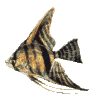 BRINE
Shrimp Hatchery
By Garry Ried
Several people have asked me how I built my BRINE Shrimp Hatchery. First of all, I can
not take credit for its design. For that I give credit to Pat and Rich Coogan. I had seen
theirs and got instructions from Pat on building it.
The material that is need is very basic. You may even have most of it around the house.
You will need the following items:
1). A two liter soda bottle
2). An empty plastic peanut butter jar
3). 3/16 inch drill bit
4). A small length of hard air tubing
5). Soft air tubing
To start, cut off the bottom of the soda bottle. This will serve at the top of the
hatchery when it is in place. I cut the bottle at the small rib that is formed by the
sidewall and the bottom. The next step is the most critical. Remove the cap from the
bottle. Remove the plastic lining from the inside of the cap. Next, drill a 3/16-inch hole
in the center of the cap. Make sure that you get as clean of hole as possible. The short
length of hard air tubing is inserted into the hole. At this point make sure that the
joint between the tubing and the cap does not leak. You will need to drill a new cap or
seal it with silicone if it leaks. If it does not leak you will be done with the main
portion of the hatchery.
Next is to build a base for the hatchery. Cut a square opening at the bottom of the
peanut butter jar. You will want to make it large enough so that you will be able to
connect the soft air tubing to the hatchery. The hatchery will sit on top of the peanut
butter jar. You will want to be careful with this, as this can be a little unstable. The
only modification I have made to my original setup is to make a more stable base out of
wood. But if you put your hatchery on a solid table you will not have any trouble.
When the hatchery and its base are built you will be ready to put it into operations.
You will need to connect the air tubing to a small air pump. I have put a valve between
the air pump and the hard tubing in the hatchery. This enables me to disconnect it when I
need to harvest the BRINE Shrimp.
Some of you may wonder what formula I use for hatching my BRINE Shrimp. I use 6
tablespoons of rock salt to a gallon of water. To this I add 1/4 teaspoon for Baking Soda.
This will increase the alkalinity of the water. When I get ready to hatch a batch of baby
BRINE I will fill the 2-liter bottle with the water. I will use 1 teaspoon of BRINE Shrimp
eggs for each batch. The BRINE eggs will hatch in 24 hours at a temperature of about 82
degrees. To keep the water warm I place a desk lamp with a 40 or 60 watt light bulb over
the top of the hatchery. By the way, I use a lid off a cottage container for a top in the
hatchery.
At the end of the 24-hour period you will be ready to feed the baby BRINE Shrimp to
your fish. How do you get the baby BRINE Shrimp out of the hatchery? First disconnect the
hatchery from the air pump. You will then want to shine the light at the bottom of the
hatchery. Let it stand for 10 to 15 minuets. In that time the unhatched eggs and the
eggshells will float to the top and the BRINE will swim toward the light. At the end of
this time I will disconnect the air tubing at the valve. Be sure to pinch the air tubing
between your fingers so that all the BRINE is not released at once. Use your finger
pressure to regulate the amount of BRINE you want to use. Use a BRINE Shrimp net to catch
the amount that you want. Rinse the BRINE under fresh water and it is ready to feed to
your fish.
This system is very good if you have a small number of fish to feed. If you have a
large number of fish this will work, but you will need to do it more often. This will
require more than one hatchery. I usually can go three days per each batch when feeding my
Discus fry.
|
